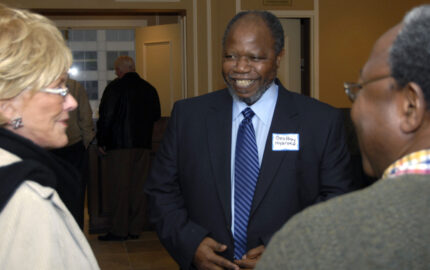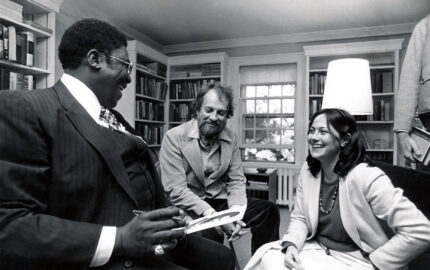Two and a half years ago, I walked out of a newsroom and onto a college campus to help build a program that could help identify and develop high school students of color who can be part of the next generation of journalists. The need is embarrassingly obvious. According to the latest census by the American Society of Newspaper Editors, the average American newsroom has 12.9 percent minority employees while the nation’s population is nearly 32 percent.
Happily, by linking the skills of newsroom professionals and journalism professors with minority teens in urban high schools, we’ve found we can have a significant and rapid impact. Using journalist volunteers, we’ve helped revive newspapers at three urban high schools in Minnesota. Already 13 students who have attended our two-week summer camps since 2001 are studying journalism in college. Several more will start this fall.
A young Hmong student who attended our programs just landed a coveted internship at a local TV station. Four alumni of our summer program—a Liberian immigrant, a Somali refugee, and two Hmong women—are studying journalism at the University of St. Thomas, a Catholic liberal arts university in St. Paul, Minnesota in sore need of such diversity.
Equally important, through work in various urban high schools, I’ve seen what a powerful vehicle journalism can be for young people to express their concerns, share their experiences, and report on the world around them.
They see good stories. They do serious work, particularly when they have good guidance. We underestimate teens when we think we can hook them on newspapers by publishing stories about J-Lo and navel piercing. With few exceptions, the kids we see in journalism classes, weekend seminars, and the two-week summer camp have weightier things in mind.
But scholastic journalism is in serious trouble in many parts of the country. Budget cuts and a back-to-basics approach to education spurred by standardized testing means that more and more schools are doing without. In Minnesota, only 58 percent of the state’s high schools have newspapers. Some of those are four pages photocopied in the school office.
The latest issue of Roosevelt Standard, the newspaper of a fortress-like public high school in Minneapolis, exemplifies what a good student newspaper can be. The place was named to honor Teddy Roosevelt. Jesse Ventura is its most famous alumnus. Now 85 percent of students are students of color, 70 percent are poor, and 37 percent speak English as a second language.
In the 1960’s, the school produced a weekly paper. Two years ago, there was only one issue for the entire year. Since then, thanks in part to journalists who work with the journalism class twice a week, eight-page papers are produced each quarter. They’re lively, timely and real. Along with news articles about the school’s new fitness room and a visit by Dr. Peter Agre, who won the Nobel Prize for chemistry, there are thoughtful essays about why kids join gangs and how it feels to be gay when classmates call each other fags and dykes as a passing putdown.
Keeping the Standard alive hasn’t been easy. Last year’s journalism teacher was laid off in a round of budget cuts, but the principal was committed to preserving a journalism class and a newspaper. He recruited the head of the school’s medical program to teach the first semester. When her husband got a job in another state, the school’s testing coordinator stepped in. Such heroic efforts are often required to keep scholastic journalism alive in urban schools.
“I think there’s something lacking if a school is without a paper,” said Roosevelt’s principal, Bruce Gilman. “The students’ voices are being heard.”
This year’s Standards show the wisdom of his commitment. Articles dealt with teacher layoffs and the state budget deficit, rising athletic fees, the threatened closing of a neighborhood library, and the inconvenience of bathrooms locked because gang members were writing on the walls. Naturally there was a horoscope, sports news and an advice column, enduring staples of high school life. The bylines reflect the school’s population: Somali and Hmong, African American and Hispanic.
By volunteering at Roosevelt, I have seen students’ efforts to overcome shyness and uncooperative administrators, crunch numbers and check facts, learn layout skills and produce crisp, clear prose in a language many of them don’t speak at home.
The head of the school’s PTA asked for extra copies for parents because it told them things their kids might not. In a survey we did, students said that working on the school paper improved their writing and increased their interest in news. They were achingly proud of what they’d done. One student wrote: “This newspaper will live in my scrapbook forever.”
In that classroom, I saw the value and power of teaching students the journalistic process. So many young writers know only the formality of academic essays and the looseness of poetry. Journalism is conversational but exact. It requires intellectual rigor and clear expression, fairness and accuracy, separation of fact from opinion, consciousness that the writer serves an audience. You want outcomes-based education? Put out a school newspaper.
Journalists have much to gain from investing time and money in such ventures. Imagine a newsroom where a reporter whose family once lived in shelters reports on social policy. Imagine a Somali immigrant translating the refugee experience for mainstream readers. More selfishly, look at the readership numbers among younger people. Most of them aren’t getting newspapers at home. Producing a newspaper at school is one way to help them develop the newspaper habit.
Last year, when the U.S. Supreme Court gave limited approval for college affirmative action programs, it expressed hope that special breaks won’t be necessary in another 25 years. Consider that a deadline: It’s more necessary than ever to work now to create opportunities, to push kids with the aptitude and interest for journalism to perform, nudge, coach and mentor them.
Journalism is like a video game, one student told me. I asked him to explain. “You get stuck at one level. Then you have to step back and find a new way to move ahead,” he said.
It’s not a bad metaphor. It works equally well for those who get discouraged that we haven’t made more progress in diversifying the newsroom. We’re stuck at one level. Stepping back and investing more in high school journalism is exactly what we need to move ahead.
Lynda McDonnell, a 1980 Nieman Fellow, is the executive director of the Minnesota Media Collaborative at the University of St. Thomas in St. Paul, Minnesota. She was previously the political editor for the St. Paul Pioneer Press, where she worked in a variety of roles for 20 years.



